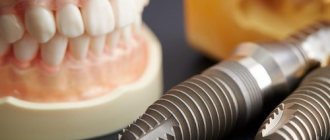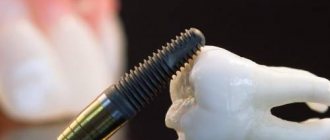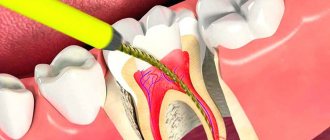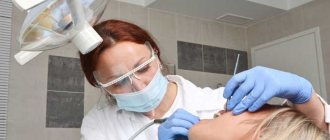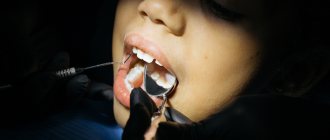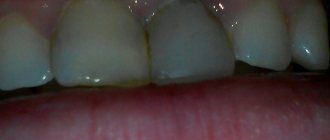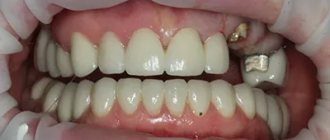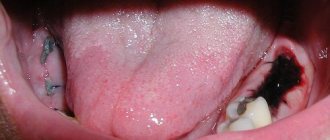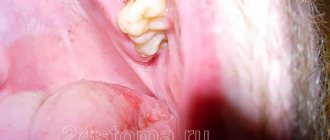What symptoms accompany implant mobility?
There are two possible scenarios:
- there is no inflammation of the tissue around the implant, and it just wobbles, but does not hurt,
- the implant wobbles due to inflammation and pain in the jaw.
Of the possible complications, the first “scenario” is the least dangerous condition, which is most often caused by errors of the specialist installing the structure, and a number of diseases that affect the rate of osseointegration (diabetes mellitus, for example). In this case, the patient simply feels the mobility of the metal rod 2–3 weeks after the operation, the implant wobbles a little. The soft tissues around retain their former natural appearance, there is no pain or change in condition in the oral cavity. This is the most favorable outcome, allowing you to correct the situation with the least damage to your health and wallet.
However, the implant can also wobble due to poor-quality installation, as well as complete failure to engraft into the bone. This situation is not favorable - most likely, the product will have to be removed.
In the second case, mobility against the background of inflammation is a serious symptom that indicates rejection of the structure. And the instability of the structure, as a rule, occurs after the long-term existence of other signs of inflammation:
- the gums around the implant have changed color, become bright red, bluish, unevenly colored,
- there was slight swelling,
- the mucous membrane does not adhere tightly to the artificial structure, partially detaches from its surface,
- when chewing, pain occurs, as well as when touching the gums,
- bleeding gums around the implant,
- the appearance of a putrid odor from the area of the installed implant,
- discharge of pus from under the gums,
- body temperature remains elevated to 39°,
- there is a general malaise.
All these symptoms indicate developing mucositis or peri-implantitis - first superficial, and later deep inflammation of soft and bone tissues.
In both cases, you should not wait for the situation to improve; you should immediately seek professional help. Read more about the unfavorable outcome of implantation in the material “Dental implant rejection.”
What will happen if you do nothing?
A loose implant is prone to worsening its own condition - the negative phenomenon will definitely not go away on its own and will not remain at the same level unless you consult a doctor. At a minimum, the implant can fall out - just like an ordinary tooth. Such a process will definitely not be painless; it is always accompanied by gradual infection and suppuration of the gums, with a further deterioration in the general condition of the body, including an increase in temperature. Negative processes also contribute to the destruction of bone - it can be restored, but this requires time and money, and most importantly, it postpones the re-implantation of a new implant and a return to normal life until the distant future.
When it is not the implant that is loose, but the crown on it
How to determine whether an implant or crown is loose? The entire structure, which completely replaces the tooth, consists of several elements - an artificial root, an abutment and a crown that replicates the outer visible part of the tooth. Depending on the type of structure and the method of fastening the crown, the connection of the parts to each other may be different.
Read more about fixing crowns to an implant in the material “How to choose a crown for an implant and which ones are better? Review of modern single prostheses and methods of their fastening.”
It is possible that the screw fastening between the crown and the abutment may loosen or the properties of the cement composition may be lost for a number of reasons. But the implant itself can also become loose. However, at home it is difficult to reliably determine which element has weakened the fixation; this requires assessment and diagnosis by a specialist.
If it turns out that the crown is indeed weakened, then you can return it to its place in the clinic where the implantation was performed. Such cases occur more often with temporary crowns. The doctor will tighten the screw with a special tool and secure it to the implant. When the elements are cemented together, the crown “sits” again after cleaning.
Reviews
We wish all patients who have undergone implantation not to encounter such a problem as the unsteadiness of the crown or prosthesis.
But, if you nevertheless suffered such a sad fate, tell us what caused the mobility of the crown and how you dealt with it. You can do this by leaving a comment at the bottom of the page.
If you find an error, please select a piece of text and press Ctrl+Enter.
Tags dental crowns fixed dentures
Did you like the article? stay tuned
Previous article
Unique Sia braces – the orthodontic art of Italy
Next article
Empress inlays - reliable dental restoration while maintaining functionality
What causes implant loosening - the main reasons
If a tooth implant begins to wobble, then the reasons for this must be sought in one of three directions. Among them:
- physician errors: rejection due to specialist errors is noted at the initial stage of implantation of the structure (in the first 3–4 weeks) and indicates a poorly performed operation. We will look at possible errors in more detail below.
- systemic diseases and conditions of the patient: they affect the rate of osseointegration or affect the implant that has already taken root. If the cause is disease (periodontitis, hormonal changes during menopause or menstruation in women), then part of the reason for rejection can be considered the shortcomings of the preparatory period on the part of the doctor, who did not take their presence into account. Also, a patient can hide his illnesses from the doctor and, at his own peril and risk, decide to have an operation, the result of which will be rejection. Mobility may occur 5 years or more after implantation due to the appearance or development of systemic diseases, the occurrence of which is difficult to predict,
- patient errors: they are mainly related to the care of installed structures and prevention. By maintaining a level of hygiene for implants and prostheses, the patient creates conditions for their long-term service. Ignoring the requirements can also lead to such unpleasant consequences as inflammation of the tissues around the implants, which, as it progresses, leads first to mobility and then to rejection of the structure.
We must not forget that we are considering exceptional cases of implant mobility and rejection. In general, clinical practice and statistics[1] indicate 2–5% of such cases.
Symptoms
The patient may not yet understand that the implant is already loose, but other characteristic symptoms may tell him about this. Loosening of the implant is always caused by weakening of the gums or bone, so the phenomenon is often accompanied by swelling and redness of the soft tissues, bleeding and suppuration, as well as pain. In addition, there is a constant unpleasant odor from the mouth, which cannot be eliminated even by regular brushing of teeth.
The survival rate of high-quality implants remains at the level of 90-95%, that is, some risk of rejection remains in any case. It is important for the patient not to lose vigilance, because the problem can appear either after a few days or years later. Unpleasant symptoms detected at any time after implantation are always a reason to immediately consult a doctor.
Implant mobility caused by erroneous actions of the doctor
If the implant begins to wobble during the healing period, for example, a month after installation, then the problem most often lies in the incorrect actions of the doctor while preparing the patient for implantation and directly during the installation operation. Since implantation is a complex undertaking, the doctor may make mistakes at different stages, both at the beginning and directly during the surgical intervention.
During preparation
Receiving false information about the condition of the bone where implants will be implanted. This is possible with insufficient and uninformative diagnosis, when other methods are used instead of computed tomography - orthopantomogram (OPTG) or radiography.
Incomplete preliminary examination (or complete refusal of it) of the patient to determine if he has relative and absolute contraindications that make implantation difficult or impossible. It is also possible that the doctor will not take into account the special hormonal status of women (menopause, postpartum or menstrual period) and will allow surgery during this period without taking into account the condition.
During the preparation of the treatment plan
Incorrect assessment of the place for the implant in the bone, the location of the artificial structure is too close to the roots of living teeth, with insufficient bone tissue.
Directly during surgery
There is a wide scope for incorrect actions: violation of the sterility of instruments and equipment, bacteria entering the prepared hole along with saliva, or when the edge of the implant touches any surface. The use of improperly sized implants, the use of structures for a different surgical protocol, overheating of the bone tissue when forming a bed for the implant, installation of the rod at the wrong angle, excessive deepening of the rod, etc.
For prosthetics
During the manufacture of the prosthesis, violations may occur, resulting in incorrect distribution of the chewing load, inconsistency of the prosthesis with the implants, penetration of the cement composition into the socket, prosthetics of only one row without taking into account the load on the second, and others.
In order not to encounter unpleasant consequences of implantation, a specialist must be chosen carefully, based on many indicators of his work. How not to make a mistake with your choice, read the material “How to choose a doctor and clinic?”
Systemic diseases and body conditions affecting the fixation of implants
These include chronic diseases that make up the list of contraindications for implantation. They may go unnoticed or deliberately hidden by the patient, or appear much later, when the implant has been standing for several years.
Read about indications and contraindications for implantation in the feature article on the website “When you can or cannot place dental implants - a complete list of tolerances and prohibitions.”
Dental implant failure can occur due to the following diseases:
- diabetes mellitus in a long stage of decompensation,
- pathologies of the central nervous system,
- disruptions in the body's immune system,
- development of oncological tumors of any localization and subsequent therapy,
- allergic reactions in the oral cavity to the components of an implant or prosthesis,
- trauma of the maxillofacial apparatus,
- oral diseases
To avoid unexpected consequences of these diseases, experts recommend regular preventive oral examinations and monitoring of chronic diseases.
The occurrence of implant mobility due to patient negligence
Here it mainly concerns oral hygiene and the rules of care for implants and prostheses installed on them. If the doctor performed the operation competently, taking into account all the patient’s characteristics, then the responsibility for the rehabilitation period falls 90% on the patient’s shoulders. If a dental implant wobbles due to gum inflammation, this indicates an extreme degree of peri-implantitis. Complications at this time and much later are possible for a number of reasons:
- refusal to take medications prescribed by a doctor to restore tissue, prevent inflammation, etc.,
- smoking and drinking alcohol after surgery, unwillingness to give up bad habits in the future. It is known that smokers experience implant rejection twice as often[2] (7% of cases) than those who are not exposed to the bad habit.
- insufficient daily care of dentures and implants, lack of proper hygiene, accumulation of bacterial plaque around implants,
- overload of implants when chewing too hard food, untimely (too early) load on the rods.
All this leads to the development of inflammation and, without treatment, to implant mobility and, ultimately, to rejection of the structure.
Read about the organization of comprehensive oral care after implantation in the thematic material on the website “Care for the oral cavity and dentures after implantation.”
